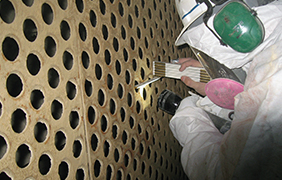Aerobic digestion is a series of biological processes that take place in the presence of oxygen. These are typically run as a batch process with more than one digester tank in operation at any given time. Air must be pumped through the tank and the contents must be stirred often to stay mixed and to maintain the excess of oxygen throughout. Where non-sewage waste is processed, organic waste can be reduced in volume leaving an end product that can be used as fertilizer or biomass fuel.
The Process
There are three stages of aerobic digestion
- Biomass Destruction
- Nitrification
- Denitrification
The first step in aerobic digestion is biomass destruction. In this process, food supply is depleted and microorganisms start to feed on their own protoplasm for cell metabolism. This, in conjunction with an abundance of oxygen, creates carbon dioxide, water, and ammonium bicarbonate. During the next stage, called nitrification, the abundance of ammonia is converted into nitrates. This step is accomplished by the nitrifying bacteria and happens when the ammonia molecules are exposed to the dissolved oxygen. This reduces the ammonia to water, nitrate, and two hydrogens that act as an acid. The byproducts of the combined reactions in the first two steps are carbon dioxide, water, and nitric acid. Consequently, nitric acid severely impacts the pH of the digestions and causes harm to the microorganisms in the biomass. In order to reduce the amount of acid, the final step of denitrification must occur. Denitrification is accomplished in the absence of oxygen by the denitrifying bacteria and results in the oxidation of the nitric acid. After all three steps of aerobic digestion, the byproducts include carbon dioxide, water, and a small amount of nitrogen gas.


